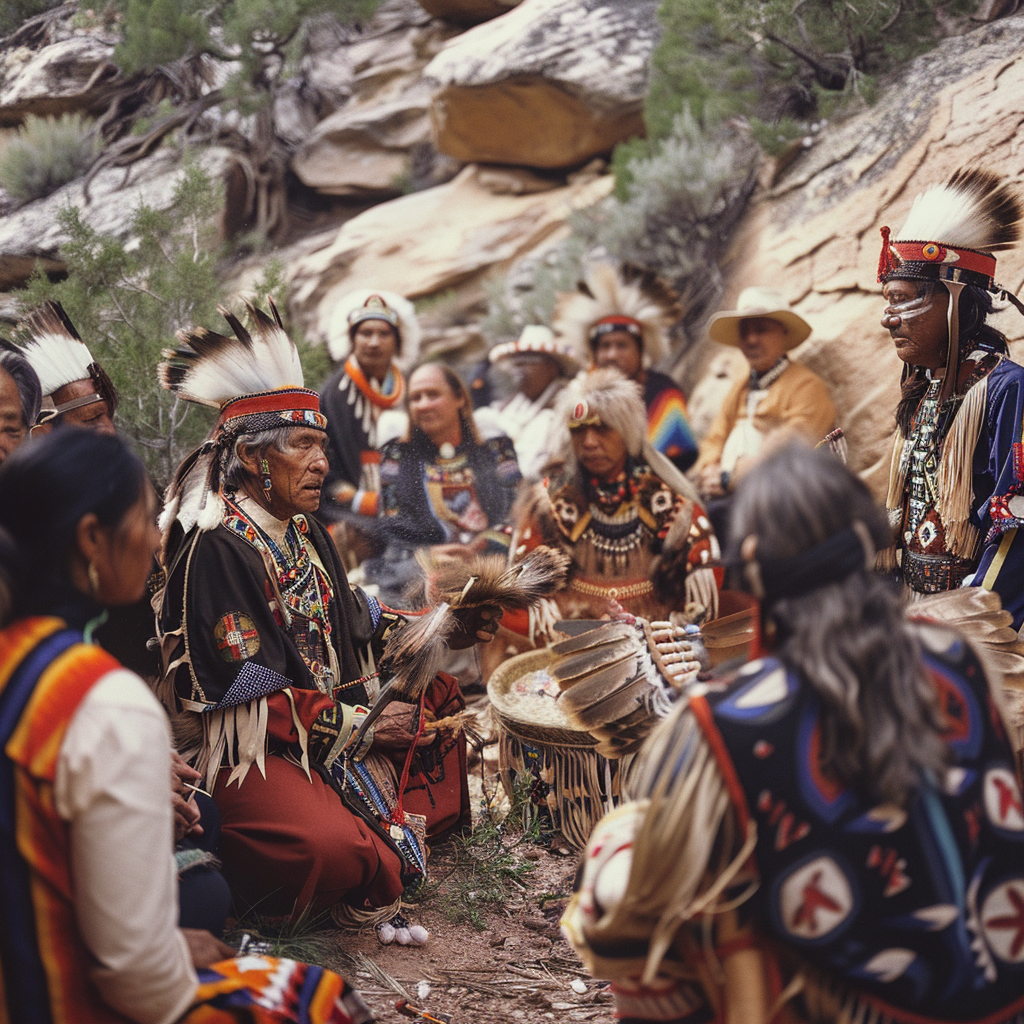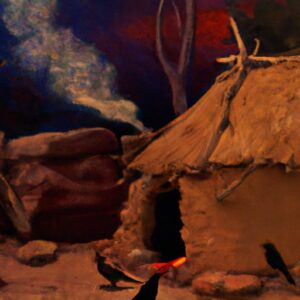– **Mountains and Valleys: Sacred Landscapes in Apache Spirituality**
Introduction
Mountains and valleys hold profound significance in Apache spirituality, symbolizing sacred spaces that connect the physical and spiritual realms. For the Apache people, these natural landscapes are more than geographic features; they are vital components of their cultural identity and spiritual practices. The reverence for these environments is deeply rooted in the wisdom passed down through generations.
Apache lore often emphasizes the importance of mountains as places of strength, wisdom, and sanctuary. These towering formations serve as sites for ceremonies, meditation, and communication with ancestral spirits. Conversely, valleys are seen as nurturing grounds, offering sustenance and shelter, while also serving as pathways guiding movement and migration.
“The mountains and valleys are our guardians and teachers, providing lessons in resilience, harmony, and the cyclical nature of life.”
This sentiment captures the essence of the Apache relationship with their surrounding landscapes. By studying and honoring these natural features, the Apache maintain a balance between their spiritual beliefs and their daily lives, ensuring the continuity of their traditions and respect for the Earth.
History
Mountains and valleys hold deep spiritual significance in Apache culture, representing more than just geographical features. For centuries, the Apache people have revered these landscapes as sacred spaces that connect them to their ancestors and the spiritual world. This profound respect is reflected in their oral traditions, ceremonies, and daily practices.
The history of Apache spirituality is intrinsically linked to their environment, with mountains often viewed as the abodes of deities and the sources of powerful spiritual energy. These towering peaks are seen as places of refuge and recharging, essential for the community’s wellbeing. Valleys, meanwhile, are considered nurturing spaces that support life and growth, symbolizing the sustenance provided by Mother Earth.
“The mountains are not just rocks; they are alive. They are our grandfathers. Their spirits speak to us and guide us,” an Apache elder once said, capturing the essence of this belief.
Throughout history, the Apache have performed numerous rituals and pilgrimages to these sacred sites to seek guidance, healing, and blessings. These practices have been passed down through generations, ensuring that the connection between their people and the land remains unbroken. The reverence for mountains and valleys underscores the deep bond the Apache maintain with nature, seeing themselves as its guardians and integral parts of its sacred fabric.
An Apache story
The Apache people have always held a deep reverence for the mountains and valleys that shape their homeland. These landscapes are not merely physical forms but are imbued with spiritual significance, playing a vital role in their cultural identity and practices.
According to Apache wisdom, the mountains serve as sacred places where one can connect with the spiritual world and seek guidance. They believe that the higher elevations bring them closer to the spirit beings who inhabit these peaks, making the mountains ideal sites for prayer and reflection.
The valleys, on the other hand, represent the nurturing aspects of the earth, providing sustenance and shelter. The fertile grounds of the valleys are considered blessings from the earth mother, encouraging growth and harmony within the community.
“The mountains are where we speak to the spirits, but the valleys are where we listen to the heartbeat of the earth,” says an Apache elder, encapsulating the integral balance these landscapes hold in their spirituality.
Through their sacred mountains and valleys, the Apache people maintain a profound connection with nature, honoring the diverse elements of their environment as integral parts of their spiritual journey. This connection is passed down through generations, ensuring that the wisdom of the land remains an enduring pillar of Apache life.
Under the vast, starlit sky of the Arizona desert, Elder Naiche sat by the fire, his weathered face glowing in the flickering light. The young Apache gathered around, eager to hear his wisdom.
“Long ago,” Naiche began, his voice deep and resonant, “there was a young warrior named Akecheta. He was brave and strong, but his heart was restless. He sought meaning, so he decided to climb the sacred mountain, Dzil Nchaa Si An, to speak with the spirits of our ancestors.”
Elder Naiche pointed to the towering silhouette against the night sky. “The journey was treacherous. As Akecheta neared the summit, a thick fog enveloped him. He heard a voice, ancient and wise, coming from the mist.”
‘Why have you come, young warrior?’ asked the voice.
‘I seek purpose and understanding,’ Akecheta replied. ‘The valleys below are filled with sorrow and confusion.’
The voice was silent for a moment, then spoke again, “To know the valleys, you must understand the peaks. They are bound together, each giving meaning to the other.”
Akecheta pondered these words and continued his climb. At the summit, he saw the world stretch out below him—vast plains and deep valleys, each place sacred, interwoven with the lives of his people.
“As he stood there,” Naiche continued, “Akecheta realized that the mountains and valleys were not separate, but part of the sacred landscape of life. He understood that to honor the mountains was to respect the valleys and everything in between.”
The elder’s eyes softened as he looked at the young ones. “Remember, our land speaks to us. The mountains offer wisdom, and the valleys teach humility. Both are sacred. Walk with balance and respect, and you will find your way.”
The fire crackled softly, and the group sat in reflective silence, the timeless lesson of their ancestors settling in their
Implementing it in your life
To implement the wisdom of Apache spirituality regarding mountains and valleys in your life, start by recognizing the sacredness of natural landscapes around you. Spend time outdoors and deepen your connection with the environment through mindful observation and meditation. Acknowledge the spiritual significance of the mountains and valleys as places of both challenge and sanctuary, much like the diverse experiences you encounter in life.
Reflect on the symbolic meanings behind these landscapes; mountains can represent aspirations and achievements, while valleys might symbolize periods of rest and introspection. Embrace these phases in your own life, understanding that both are essential for personal growth and spiritual fulfillment. Integrate these perspectives into your daily routine to foster a balanced and enriched existence.
- Practice regular nature walks to reconnect with the environment and cultivate a sense of peace.
- Create a quiet space at home where you can meditate on the symbolism of mountains and valleys.
- Journal about your experiences, drawing parallels between your life’s ups and downs and the landscapes you encounter.
- Engage in outdoor activities, such as hiking or camping, to physically immerse yourself in nature’s sacred spaces.
- Attend or participate in local cultural events that honor and respect indigenous wisdom and spirituality.
- Incorporate natural elements, such as stones or plants, into your living space as reminders of the sacred landscapes.
- Share your appreciation and understanding of these sacred places with friends and family to foster a sense of community and respect for nature.
By following these steps, you can cultivate a deeper connection with the natural world and its sacred significance, leading to personal growth and a more grounded existence. This practice encourages mindfulness and respect for the cycles and phases of life, helping you navigate them with greater awareness. Embracing the wisdom of mountains and valleys in your routine can bring balance, resilience, and a deeper sense of spirituality to your everyday life.
Conclusion
The relationship between mountains and valleys in Apache spirituality underscores the profound reverence the Apache people hold for the natural world. These landscapes, imbued with spiritual significance, serve as vital places of connection, reflection, and tradition. They are more than mere physical places; they represent the heart of the Apache cultural and spiritual identity.
As we explore these sacred landscapes, it’s essential to recognize and honor the deep wisdom and traditions they embody. This respect not only preserves the Apache way of life but also enriches our understanding of the interconnectedness of nature and spirituality. By learning from the Apache perspective, we can gain a greater appreciation for the sacredness of our own environments.
The teachings drawn from mountains and valleys inspire us to foster a deeper connection to the land and our communities. Embrace the Apache wisdom by nurturing and protecting these sacred places, ensuring they remain sanctuaries for future generations. Let us act as stewards of the Earth, honoring the sacred landscapes that sustain both cultural heritage and spiritual well-being.
“The land is our mother; the mountains, our ancestors. Every valley, every peak has a story.” — Apache Wisdom
The image and article have been augmented with AI.
Further Study:
- What is the significance of the bow and arrow in Apache spiritual symbolism?
- What is the significance of sacred sites in Apache spirituality?
- What is the importance of silence and solitude in Apache spiritual practices?
- What is the role of music and dance in Apache spiritual ceremonies?
- How do Apache spiritual practices influence their concept of wisdom and knowledge?
- What is the importance of the concept of harmony in Apache spirituality?
- How do Apache people view the relationship between spirituality and technology?
Thank you for reading!







